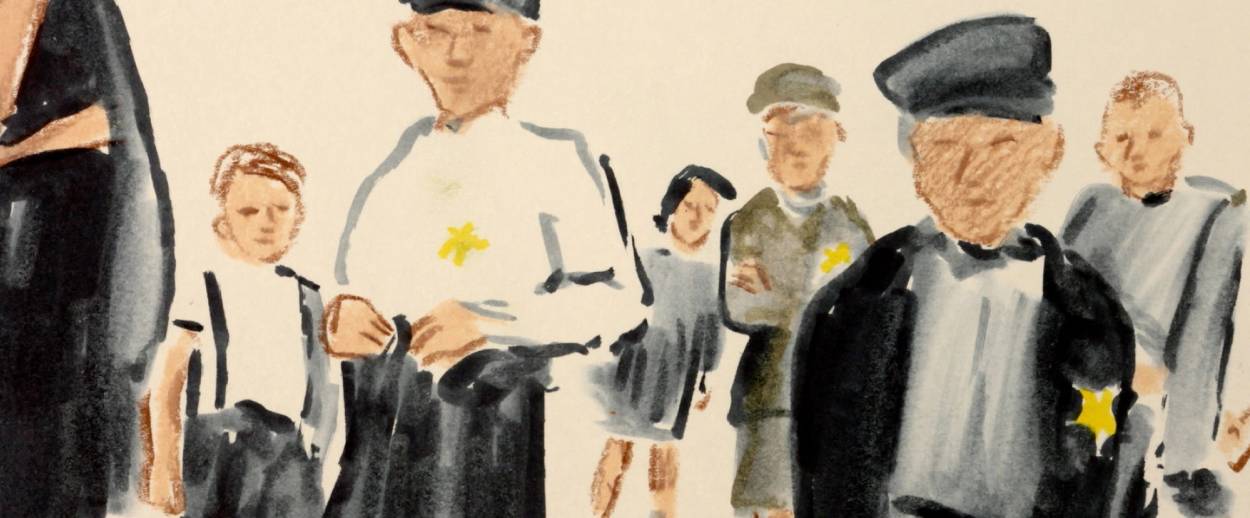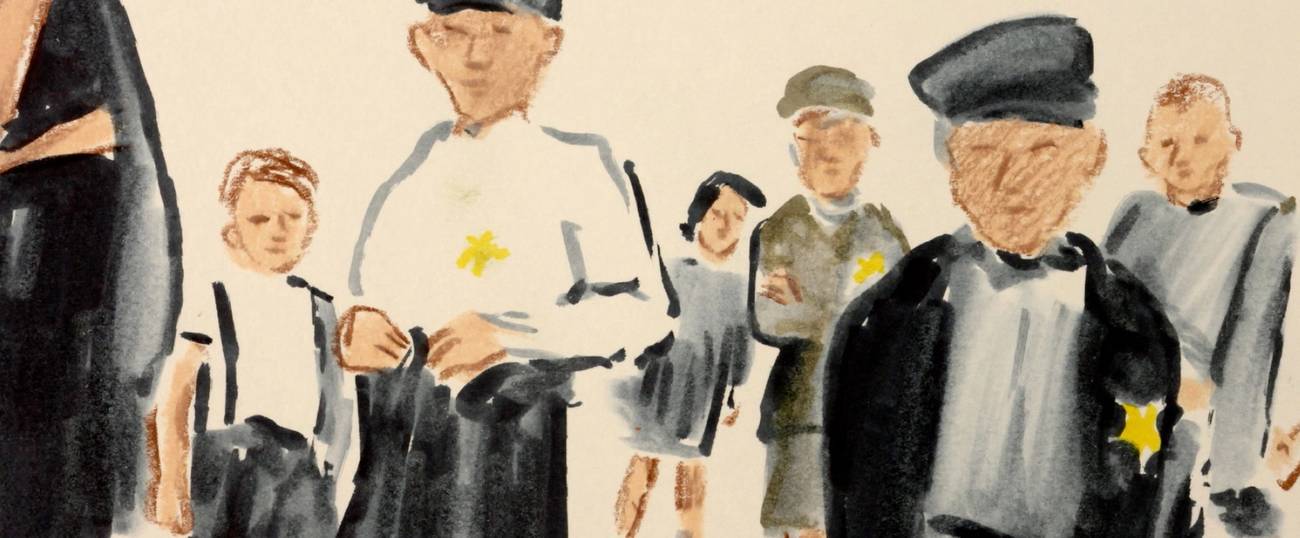Finally, an Age-Appropriate Holocaust Movie for Young Viewers
‘The Number on My Great-Grandpa’s Arm’ uses animation to elevate a documentary about a survivor and his 10-year-old great-grandson




Regular Tablet readers know that I loathe most Holocaust media for kids: apps that are flippant or misguided; slim, pornographically violent volumes of poetry featuring mental monologues by bloodthirsty Nazis; richly illustrated fables queasily blending history and legend; wide-eyed, manipulative middle-grade weepies; YA novels using the Holocaust as a jumping-off point for teen shapeshifter fantasy. And then there are the horrifying old black-and-white movies we were shown in Hebrew school, spotlighting silent footage of bulldozers pushing mountains of corpses and hollow-eyed, emaciated survivors peering blankly at their liberators from stacked wooden bunks. None of these is a good introduction to one of history’s great horrors.
But attempting to shield children from the Holocaust doesn’t work, either. I tried to keep my older daughter in the dark until she was in third grade when I thought she’d be old enough to read Number the Stars, still the best Holocaust introduction for young readers. (Fiction is the lie through which we tell the truth, as Camus put it.) Lois Lowry’s novel is exciting, based on historical fact, scary but not too scary, distressing but not paralyzingly so. Unfortunately, Josie found a Holocaust novel in second grade, in a book bin at school, with no input from me. It could have been worse: She could have started her Holocaust education at 7 with Maus, or via gory misinformation from another kid on the playground. But I wish I’d talked to her earlier.
There are fine picture books out there that can serve as a good introduction for kids under 9 to the Holocaust; families can pore over the pages and discuss them together. But not every kid is drawn to books. That’s where The Number on My Great-Grandpa’s Arm can come in. This new HBO documentary, which debuts on Saturday—International Holocaust Remembrance Day—is perfect family viewing. It dovetails with the U.S. Holocaust Memorial Museum’s guidelines for teaching kids about the Holocaust and does so in a visually enticing, engaging way that neither sugarcoats nor terrorizes. And, bonus, it’s only 19 minutes long.
Executive produced by Sheila Nevins and produced and directed by seven-time Emmy-winner Amy Schatz, the HBO documentary (also on view with a companion installation through April 29 at the Museum of Jewish Heritage , in New York City) uses a blend of live-action and animation to tell its story. A 10-year-old boy named Elliott interviews his 90-year-old great-grandfather Jack about Jack’s childhood in small-town Poland, experiences in the Lodz ghetto and then in Auschwitz, and his immigration to America to build a new life as a fishmonger.
The relationship between Jack and Elliott is clearly special. Jack, who has deep laugh lines all around his eyes, clearly loves to joke and mimic. He exudes kindness and mischief; Elliott comes across as the more serious of the two. They lean into each other on a big comfy couch, hold hands, and cuddle as they look at old family albums. When Elliott asks hesitantly, “Do you know what happened to your father?” Jack repeats in his old-world accent, “What happened? No! I never saw him, I never knew it, what happened. I never knew what happened to my mother and my father. I never saw them again.” The camera pans down to Elliott’s fingers, gently stroking his great-grandfather’s wrinkled, liver-spotted hand.
The narrative alternates between Elliott and Jack’s conversation, Elliott talking to the camera, and gorgeous animation. A photographic image (a postcard, an old photo) dissolves into a motile, richly colored, Rotoscoped watercolor, full of emotion and texture: alive-feeling. We see colorful glimpses of Jack’s life as the son of a prosperous hatmaker—kids swimming and jumping rope, adults in snazzy 1930s outfits strolling on the street. When the Nazis come, the palette switches to black, white, gray, and red, with yellow stars on coats and peachy-pink-pale faces on the Nazis. The animation of three somber-faced little boys sitting on a bench in front of three bowls of soup stops flickering and turns into a photo. There’s a map of Europe in pale greens, reds, browns; as the Nazis invade each country, it turns black. But Jack, reassuringly, keeps grounding the viewer in the present. When Elliott asks him if the Nazis scared him, he laughs. “Sure they scared me!” The animation of Auschwitz looks smeared, scary—almost like white grease pencil on a black slate—but again, not so terrifying that a viewer shuts down. When the liberators arrive, the animation feels lighter, airier, as the prisoners smile from behind barbed wire at their rescuers. The end of the short film is entirely live-action, full of bright colors, as Elliott and his little brother visit Jack’s fish market in inner-city Rochester, sit on a dock and look at the beautiful water, stroll across a green lawn. “A nice day today!” Jack says. “I enjoy very much with you, to be with you. When you coming to see me again?”
In an interview, animator Jeff Scher (whose work is in the permanent collections of the Museum of Modern Art, the Pompidou Centre, the Vienna Kunsthalle, and other museums, and who teaches animation at NYU and at the School of Visual Arts) told me, “Everything starts with the footage.” The production team went through archival films and photographs, projected films a frame at a time onto paper, and used each image as a reference for hand-painted watercolor animation. “Every drawing is photographed for two frames,” he said. “There are 12 drawings per second.” The six minutes of animation took almost a year to create.
“The idea is to be as authentic as possible,” Scher continued, “so every shot is directly relevant to the story. If it wasn’t the right camp, we wouldn’t use the film, because the uniforms were different. Every camp had its own stripe. I found some color photos of the actual garments, so I could mix the color to match it.” I told Scher that I was glad the Nazis still had color in their faces; that they still looked like people instead of black and white monsters. Scher replied, “That way they become alive, not like silver ghosts. It’s easy to dismiss the old films as a silver-nitrate hallucination … but adding a through-line of supporting this character makes the story more understandable and digestible. As the color from before the war bleeds out, we take people into the war gently, a sympathetic way. If we’d gone full-on into the gruesome stuff, it would actually take you out of the story. It’s all about having you identify with the kid as he goes through the narrative.”
To me, the flickering quality of the Rotoscope animation was a good thing; it reminded me of the jumpy, kinetic quality of old films while also exorcising the ghosts of the horrid death camp newsreels I saw as a child. Snobby art people often sneer at Rotoscope (“it’s seen as threatening to the myth of artistic genius and craftsmanship,” Scher said drily) for not creating images entirely out of whole cloth. “This is a rendering of the real world,” Scher said. “It’s almost like another kind of film editing. You’re selectively removing and emphasizing. We wanted this to feel real, and for the animation not to be a filter from reality, but almost the opposite of a filter.”
The animation elevates the documentary, but the bond between the real-life Elliott (with his earnest sweetness) and the real-life Jack (with his twinkly winsomeness) grounds it. Alas, when Elliott interviews his great-grandfather face-to-face, he can sound like he’s reading lines or taking cues from outside the frame. But when he fixes the camera with his big hazel eyes and talks directly and unscripted to us, he does beautifully. “A-17606,” he says. “That was his number, and he told us back then your number was your name. That was all he was to them.” In another compelling real-world moment, a worker at the fish market points to Jack’s arm and says, “This is his number right here. And he knows exactly what it means to be hungry. Therefore, if there’s anybody hungry, he’ll feed them.” Jack founded the market in 1954 and quickly became known for his generosity in the community. When the area was swept by riots in 1964, Jack’s Fish Market was one of only two businesses spared from looting.
If the film’s name is familiar, it’s because it’s derived from a classic 1987 children’s book, The Number on My Grandfather’s Arm, by David A. Adler (still in print). Producer Nevins saw the book in the library of the Museum of Jewish Heritage when she was there for a gala in honor of Diane von Furstenberg. Immediately she wanted to make a movie (she’s stepping down this year after 38 years at HBO, having worked on films that won 26 Academy Awards and 35 Emmy Awards). At the fancy dinner, she met Elliott’s mother, Stacey Saiontz, a lawyer and philanthropist who’s on the board of the U.S. Holocaust Memorial Museum, who told her that her own grandfather was a survivor with a number on his arm. Nevins and Schatz interviewed several families for the documentary but wound up focusing on Jack and Elliott because of the chemistry between them. Like many survivors, Jack refused to discuss his wartime experiences with his own children; he opened up, though, to his granddaughter and great-grandchildren.
“They say that in like a year or two there won’t be any survivors left,” Elliott tells us. “So we’re trying to get all their stories … before they pass away.”
***
Like this article? Sign up for our Daily Digest to get Tablet Magazine’s new content in your inbox each morning.
Marjorie Ingall is a former columnist for Tablet, the author of Mamaleh Knows Best, and a frequent contributor to the New York Times Book Review.